Ratatouille
on Jul 24, 2022, Updated Jun 25, 2025
This post may contain affiliate links. Please read our disclosure policy.
This ratatouille recipe is a rich and lush version of the summery Provencal dish (and we all need to watch the movie again).
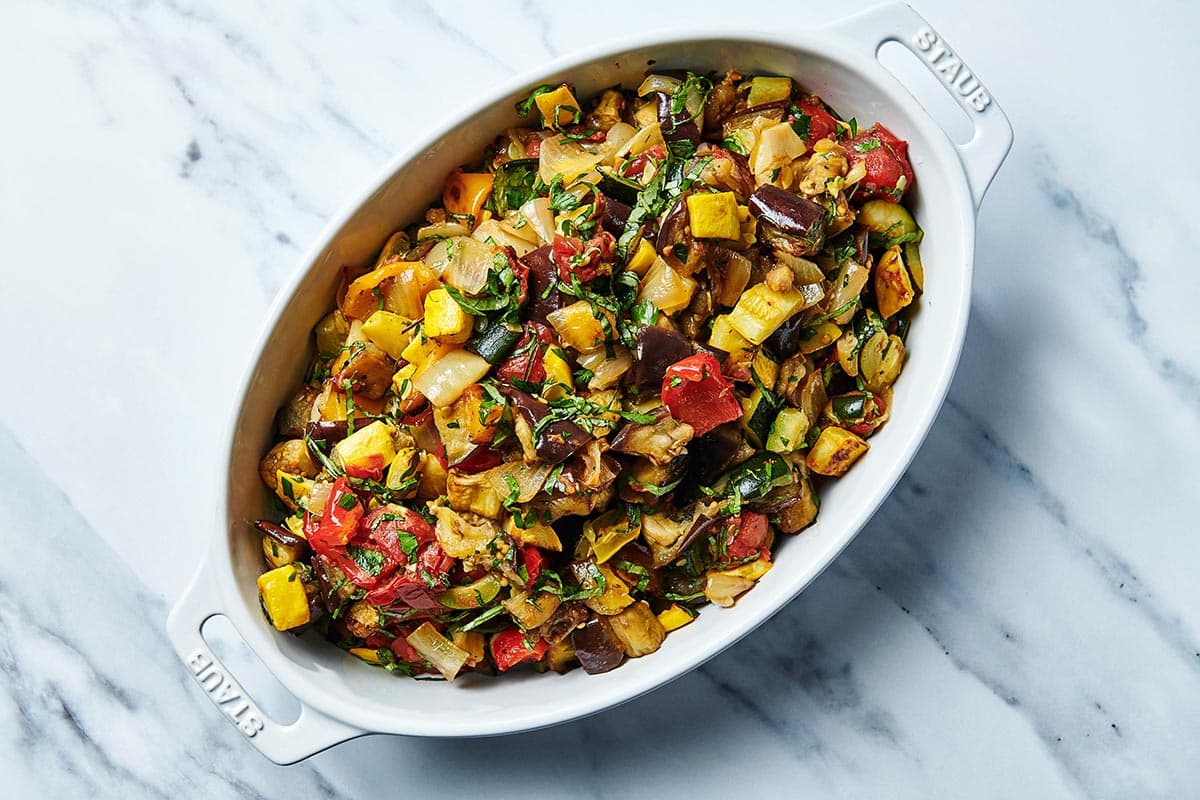
Ratatouille is a French Provençal stewed vegetable dish that originated in Nice. It is rich and bright at the same time and makes the most of late summer produce. It can be enjoyed as a main dish, or as an appetizer, and it’s not only vegetarian but also vegan. This easy ratatouille recipe makes a wonderful side for simple mains like Baked Cod or Lemon Garlic Chicken Thighs. This dish might also be called Ratatouille Niçoise.
We know this classic Provençal dish got a big boost in popularity after the animated movie by the same name came out. How could one NOT be interested in the dish that Patton Oswalt’s Remy worked so hard on? And there is a lot to unpack about the significance of ratatouille in the movie: food and class, the evolution of a peasant dish. My goodness, this is not just a children’s movie, and I am going to watch it again, stat.
By signing up, you agree to our Privacy Policy.
I was a fan of ratatouille before the movie, but also, who doesn’t love a reminder of one of the summer’s most lush ways to make use of seasonal produce? Also try this recipe for Peporanata for an Italian take on a deeply flavorful vegetable dish.
“125%… Spectacular easy to make delicious to eat very very pretty in the cooking and the eating … everything the writer said it would be and more” – Nancy
What's In This Post?
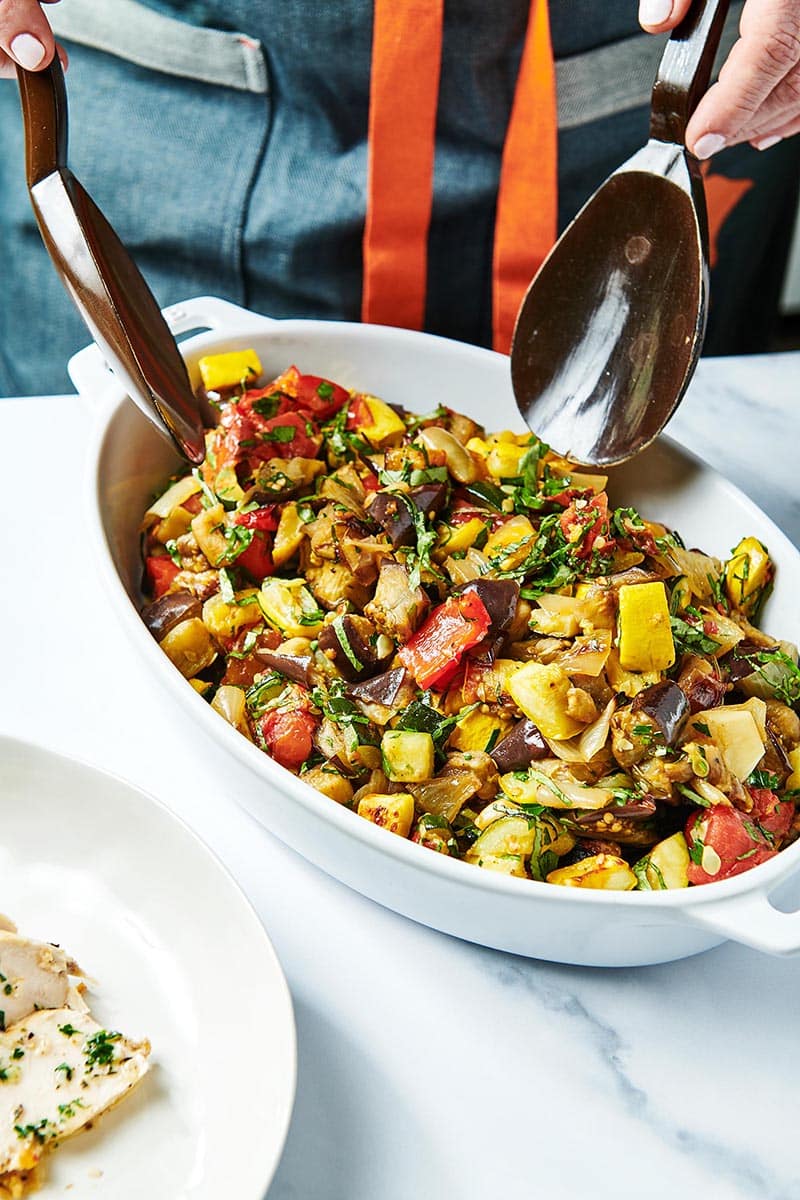
Ratatouille: A rich and lush version of the summery Provencal dish (and we all need to watch the movie again).
Ingredients
- Eggplant – Use a regular globe eggplant, trimmed and cut into 1-inch cubes.
- Kosher salt – You will use this to salt the eggplant to draw out bitterness and excess water, as well as season the whole dish.
- Zucchini
- Yellow or summer squash
- Bell peppers – I like to use a combo of one red bell pepper and one yellow or orange bell pepper for maximum visual impact.
- Onions – You can use any color onion — I like red for color, but you can use whatever you have.
- Olive oil – Use the best olive oil you have, and don’t skimp! The olive oil really adds flavor to this dish.
- Tomatoes – Make sure your tomatoes are ripe but still firm.
- Garlic cloves – Crushed fresh garlic adds amazing flavor to this stew.
- Fresh herb sprigs – I like a combo of thyme and rosemary, which are quintessential Provençal herbs.
- Fresh parsley and basil – Added at the end, this provides a burst of herbal freshness.
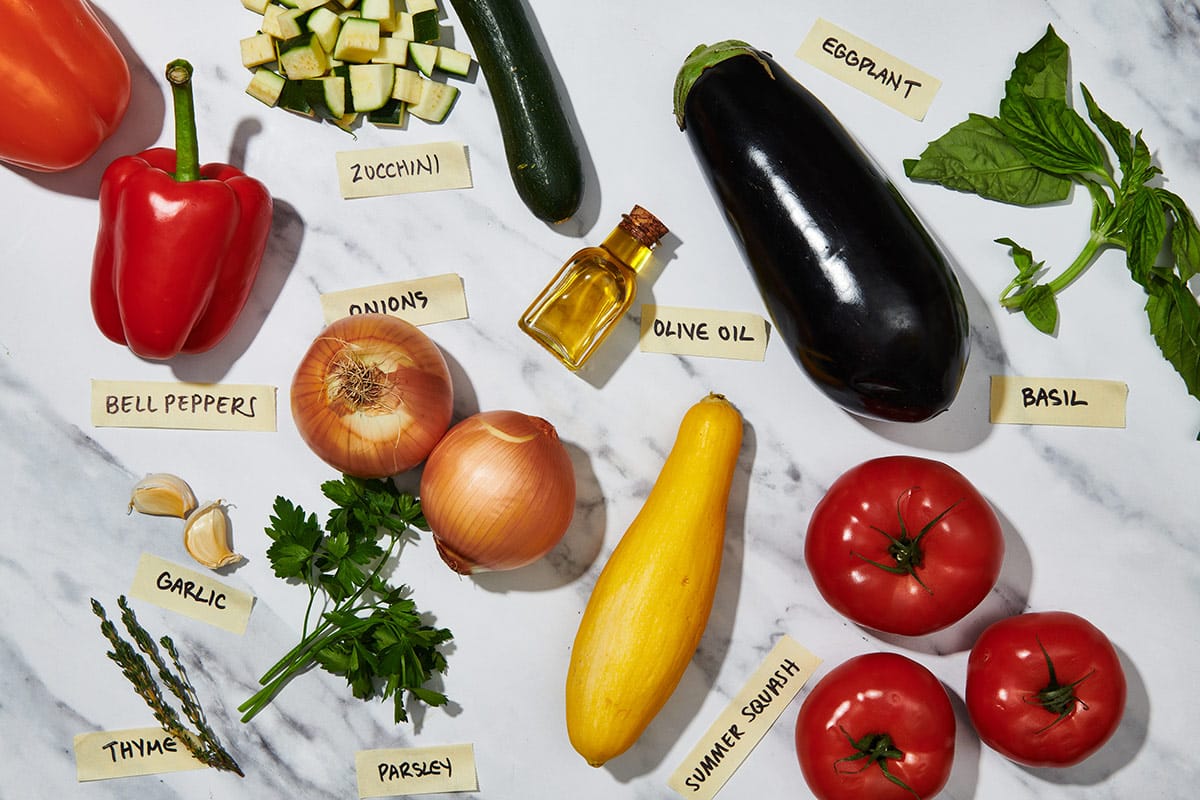
Substitutions
- Fresh herbs are infinitely preferable for this seasonal vegetable explosion. If you don’t have those available, you can add a generous pinch of dried thyme and rosemary to each batch of the vegetables, and toss to combine (herbs de Provence is another classic Provençal herb blend to pair with ratatouille).
- Use other herbs if you prefer, like oregano or marjoram.
Cooking Vegetables for Ratatouille
Some classic ratatouille recipes call for each vegetable to be cooked separately, and then combined all at the end. The reasoning for this is that it preserves the flavor and visual appeal of each individual vegetable. Even when they all get combined at the end, the result is a medley of distinct flavors and colors, rather than a blurred vegetable stew.
I think this high-heat roasting method allows for the same results, without so much high-maintenance hands-on cooking. I also want each vegetable to have its own presence in the medley. In the end, they are all coming together into one dish, so I don’t think we need to be too precious about cooking the vegetables together.
The satisfying texture of this dish is very comforting. And, there will be plenty of texture as some of the vegetables will be quite soft (the zucchini, summer squash, eggplant, and tomatoes), while others will have some firmness and bite to them (like the onions and peppers).
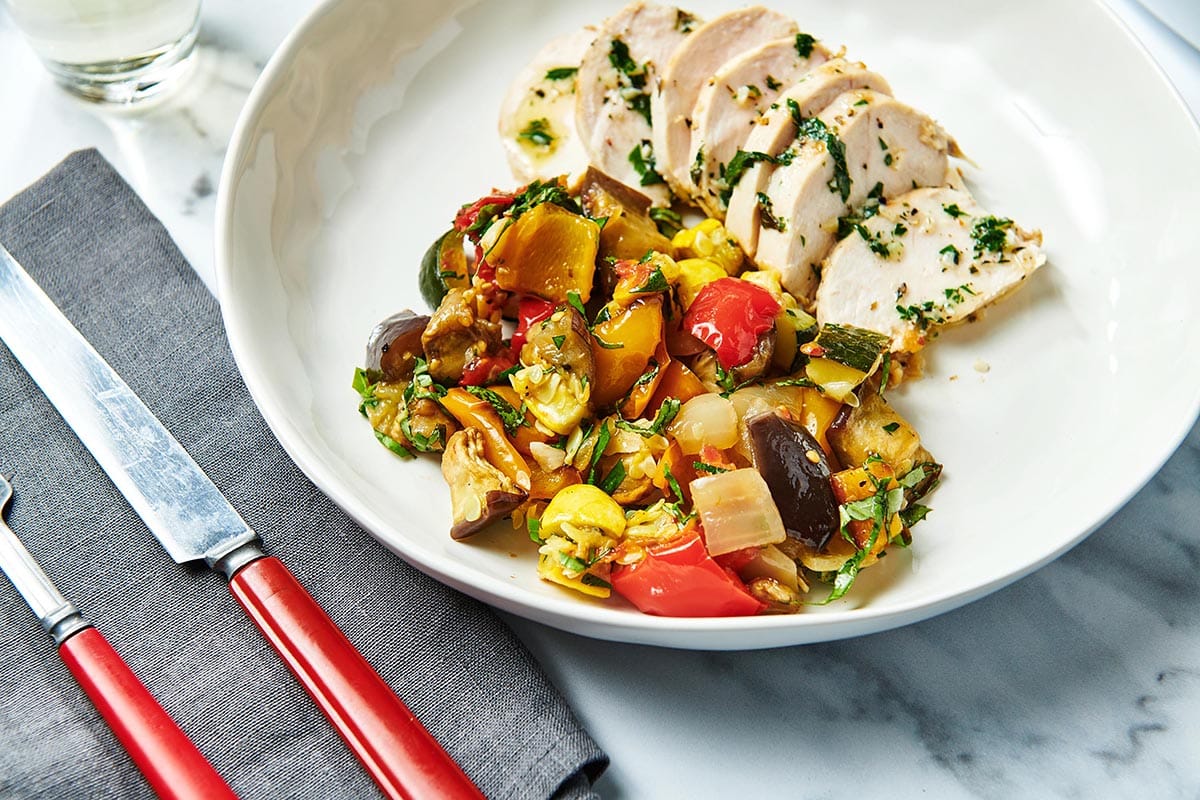
How to Make Ratatouille
There are quite a few ways to make ratatouille, and people who have made it for years tend to feel very invested in their method. There are stovetop stewing methods, oven-baked methods, and grilling methods, and you can get to a great ratatouille using any of these cooking techniques. For year-round ratatouille, or at least ratatouille that doesn’t require me to go outside to grill, I like roasting the best. It’s the most hands-off, and the oven is the most efficient way of getting all of these beautiful vegetables evenly tender.
- Preheat the oven.
- Salt the eggplant: Place the cubed eggplant in a colander, sprinkle with salt, and toss. Leave for 20 minutes. Blot the eggplant dry.
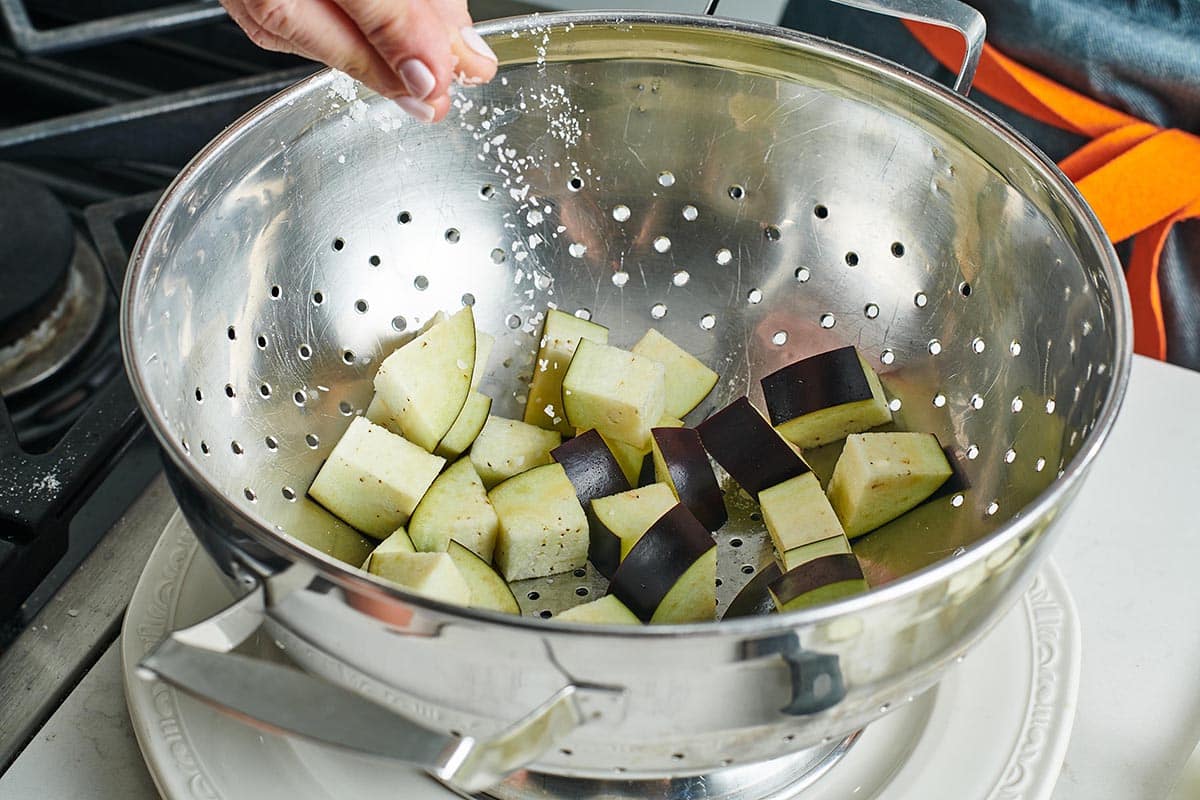
- Roast the vegetables: Tuck the garlic, thyme, and rosemary amongst the veggies.
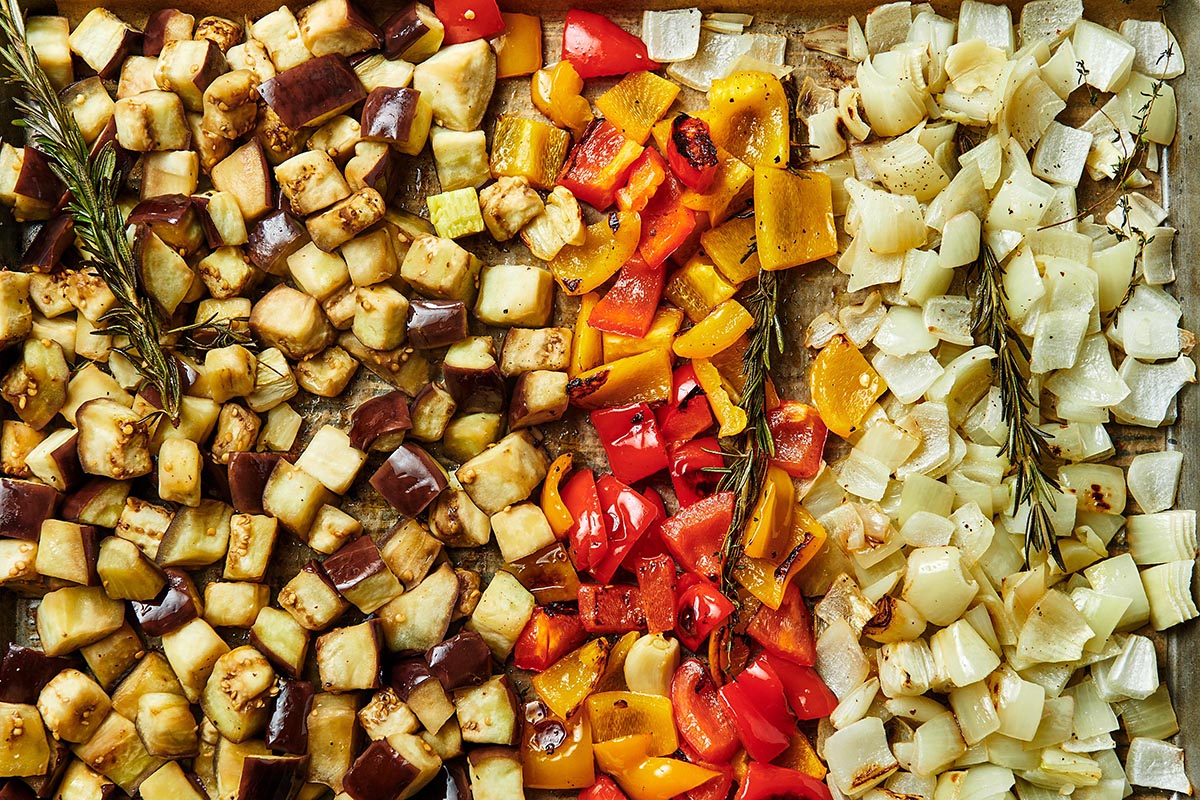
- Season and serve: Combine the roasted vegetables with the fresh herbs. Taste and adjust seasonings as needed. Serve the ratatouille hot, warm, or at room temperature.
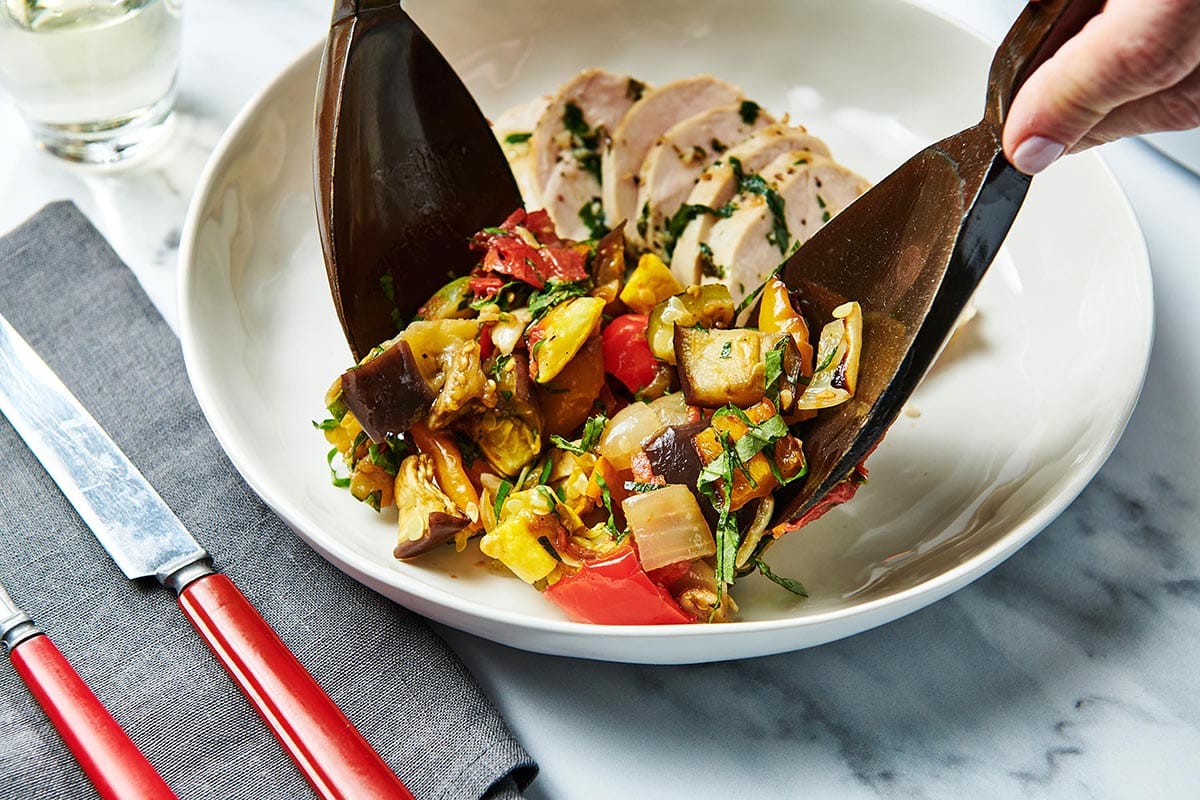
FAQs
Ratatouille is usually made from a combination of eggplant, tomato, zucchini, and bell peppers. It is made with olive oil and often includes fresh herbs and garlic.
Ratatouille is extremely versatile, and delicious, hot, room temperature, or cold.
It’s not hard to make technique-wise, but there are quite a few vegetables involved. Cutting them takes a little bit of time, but this recipe is much easier than most because the vegetables are roasted, and can be combined on the sheet trays. Some recipes call for each vegetable to be cooked separately, which is much more time-consuming.
Ratatouille should be made with vegetables at their seasonal best. Fresh herbs also are key to a really great ratatouille.
Roasting the vegetables in groups on the sheet pans allows them to maintain their distinct flavors and textures. Adding the tomatoes later in the roasting process also allows them to maintain their fresh flavor, and prevents them from collapsing into mush.
Letting the vegetables cool a bit before combining them also helps keep each vegetable distinct. Then, when they are combined, they keep their independence, texturally and flavor-wise. This makes the dish much more interesting and also visually more attractive. Cooking the vegetables in a pot all at the same time will result in a perfectly delicious vegetable stew, but one with a more homogenous flavor and texture profile.
In French, “touiller” means “to stir up.” This refers to the fact that the vegetables are all stirred together at the end to create this dish.
What to Serve With Ratatouille
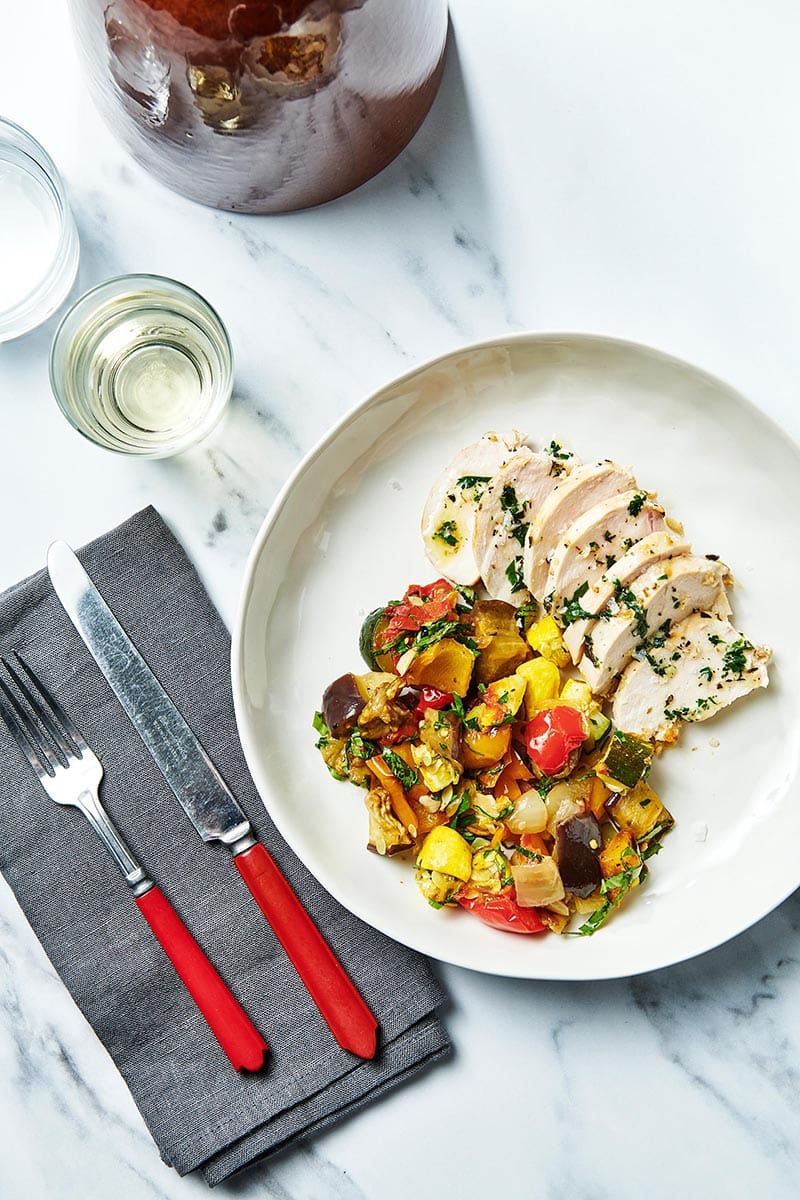
More Vegetarian Summer Recipes
- Greek Orzo Salad
- Grilled Vegetable Skewers
- Cherry Tomato Antipasti Salad
- Tomato Mozzarella Pasta Salad
Pin this now to find it later
Pin It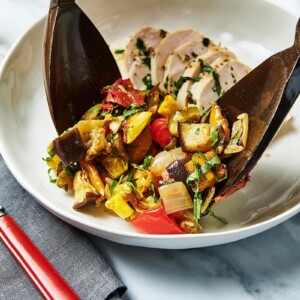
How to Make Ratatouille
Ingredients
- 1 large eggplant (about 1 pound; trimmed and cut into 1-inch cubes)
- 1 teaspoon kosher salt (plus more to taste)
- 2 medium zucchini (trimmed and cut into 1-inch cubes)
- 2 medium yellow or summer squash (trimmed and cut into 1-inch cubes)
- 1 red bell pepper (cored, seeded, and cut into 1-inch pieces)
- 1 yellow or orange bell pepper (cored, seeded, and cut into 1-inch pieces)
- 2 large onions (any color; peeled and cut into 1-inch pieces)
- 9 tablespoons olive oil (divided)
- freshly ground black pepper (to taste)
- 3 medium ripe tomatoes (2 pounds total; cored, stemmed, and cut into 1-inch chunks)
- 8 garlic cloves (crushed)
- 4 sprigs fresh thyme
- 4 sprigs fresh rosemary
- 2 tablespoons roughly chopped parsley
- ½ cup thinly sliced (chiffonade) basil
Instructions
- Preheat the oven to 450 F. Make sure you have one oven rack positioned in the bottom third of the oven and one on the top third. Line two rimmed baking sheets with parchment paper, if you have it. Either way, spray them with nonstick cooking spray.
- Salt the eggplant: Place half of the cubed eggplant in a colander, and sprinkle it with ½ teaspoon kosher salt. Scatter the rest of the eggplant over, then sprinkle with another ½ teaspoon salt, then use your hand to quickly toss the salted eggplant. Leave it sit in the sink place or over a bowl to catch the liquid, for 20 minutes. Turn the eggplant onto a clean dishtowel or paper towels and blot until fairly dry.
- While the eggplant is being salted, place the onions on half of one of the sheet pans, drizzle over 2 tablespoons of the olive oil, and toss to coat. Spread out on half the sheet pan. Add the red and orange bell pepper to the other side of the sheet pan. Drizzle the peppers with 2 more tablespoons of the oil, toss, and spread out to cover the second half of the sheet pan. Sprinkle with salt and pepper.
- Do the same thing with the other sheet pan: On one half toss the blotted dry eggplant with 2 tablespoons olive oil, and on the other side, the zucchini and summer squash with 2 more tablespoons of olive oil on the other side. The vegetables should be a bit crowded, but still in a single layer. Sprinkle with salt and pepper.
- Tuck the smashed garlic cloves, and sprigs of thyme and rosemary will nilly amongst the vegetables, distributing them evenly.
- Roast the vegetables for 15 minutes, then remove the trays, and give each tray a good stir, trying to keep the vegetables on their own sides of the baking sheets. Shove the eggplant over towards the peppers so that it opens up about a third of the space on the sheet pan. Add the tomatoes, to the space, drizzle with the remaining tablespoon of oil, and give a quick salt and pepper sprinkle. Return the baking sheets to the oven, but switch which rack they are placed on. Roast for another 20 to 25 minutes, until all of the vegetables are tender and lightly browned in spots.
- Let the vegetables cool for 5 minutes on the baking trays, then scrape them into a large bowl. Add the parsley and basil, and toss. Taste and adjust seasonings as needed.
- Serve the ratatouille hot, warm, or at room temperature.
Notes
- Some classic ratatouille recipes call for each vegetable to be cooked separately, and then combined all at the end. However, in the end, they are all coming together into one dish, so I don’t think we need to be too precious about cooking them vegetables together.
- Salting the eggplant pulls out excess moisture and bitterness, but if you don’t have the time, you can skip this step.
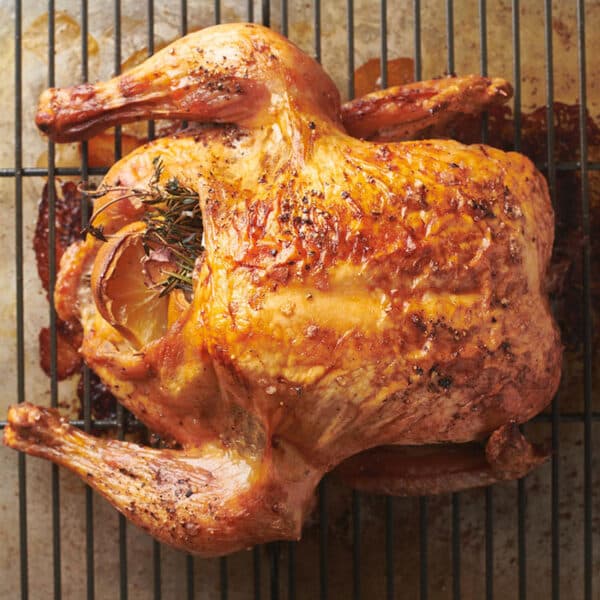
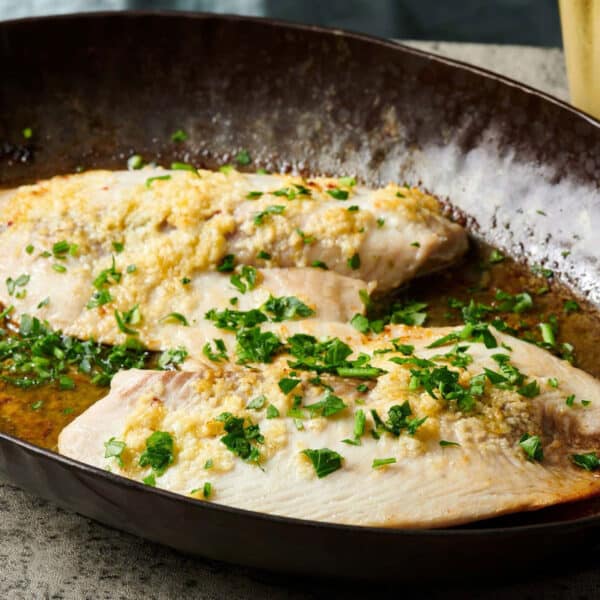
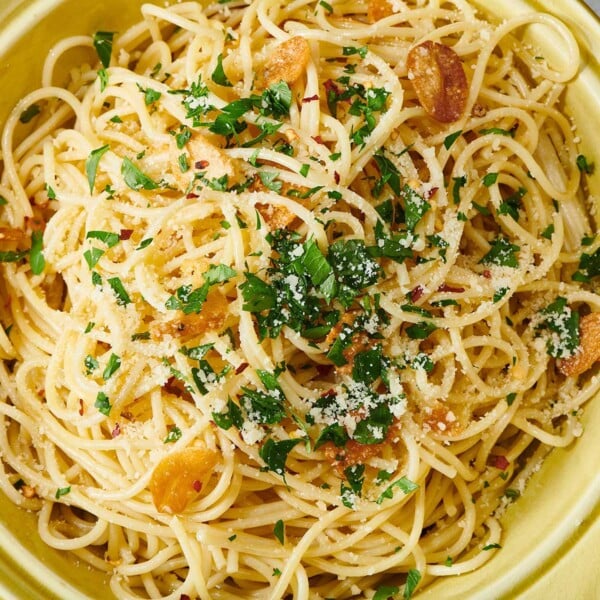
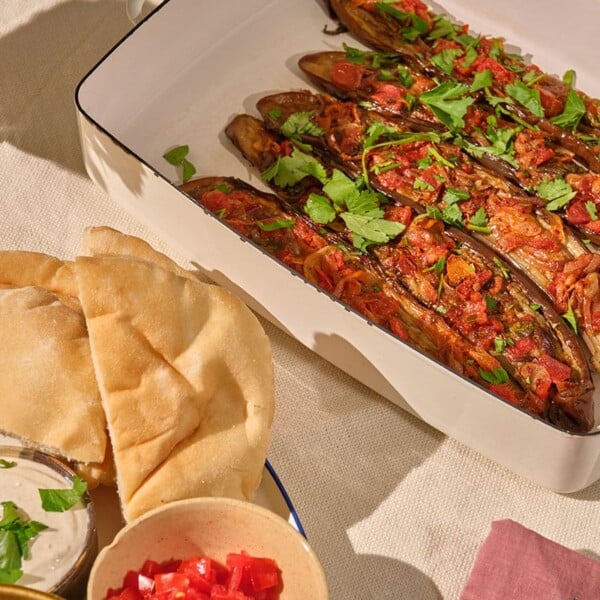
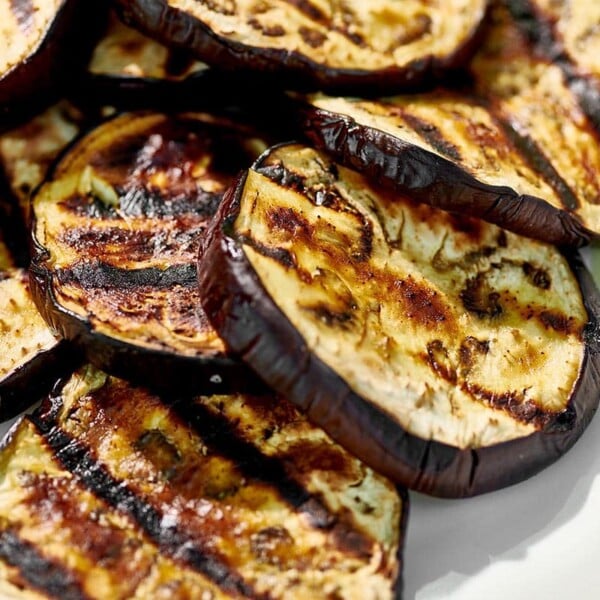
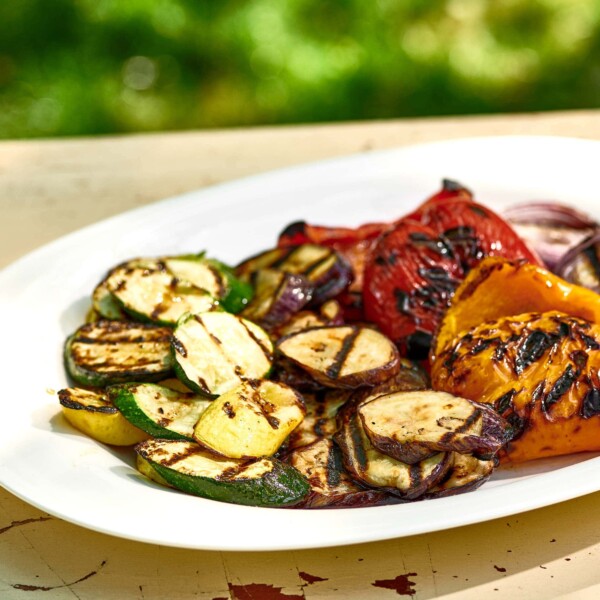
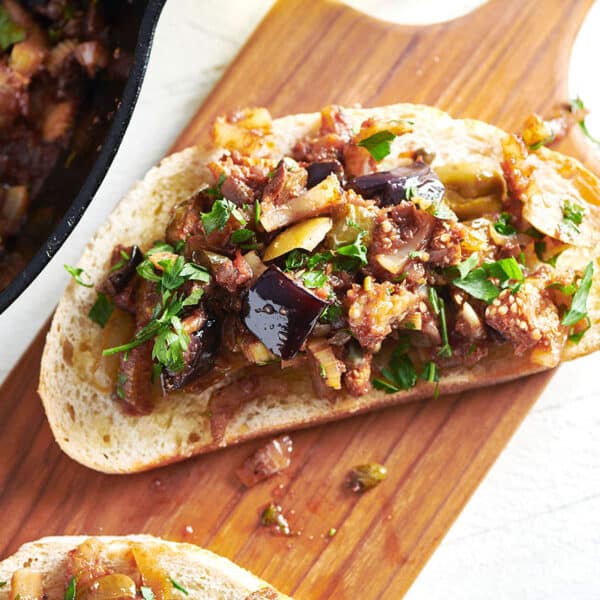









125%… Spectacular easy to make delicious to eat very very pretty in the cooking and the eating … everything the writer said it would be and more
Made it in my Ninja flip air fryer. This was incredible!!!!